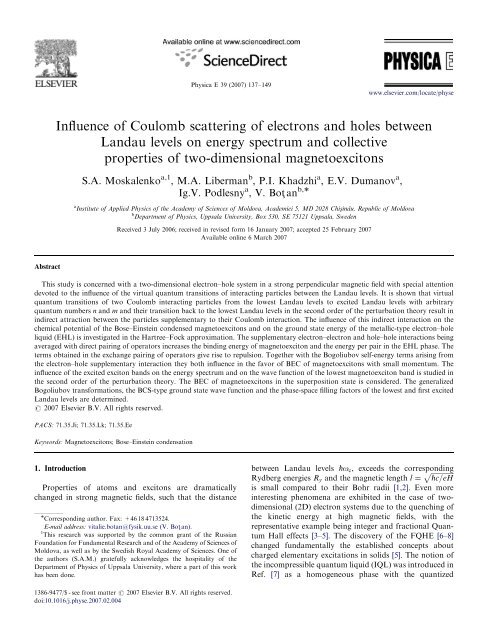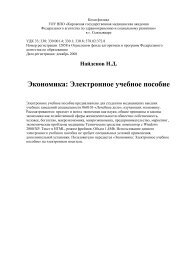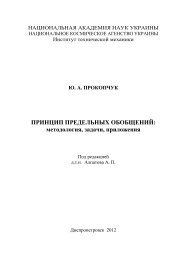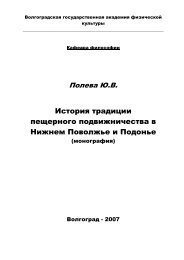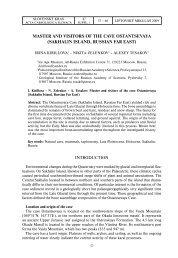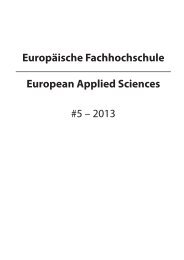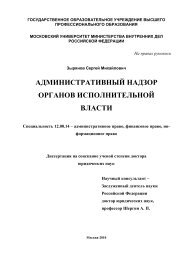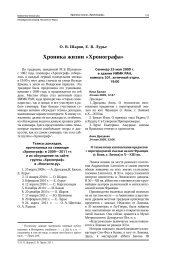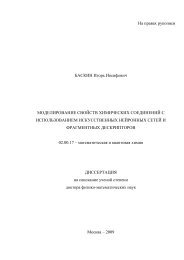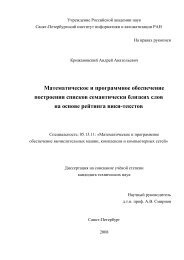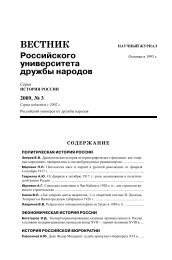Influence of Coulomb scattering of electrons and holes between ...
Influence of Coulomb scattering of electrons and holes between ...
Influence of Coulomb scattering of electrons and holes between ...
You also want an ePaper? Increase the reach of your titles
YUMPU automatically turns print PDFs into web optimized ePapers that Google loves.
ARTICLE IN PRESSPhysica E 39 (2007) 137–149www.elsevier.com/locate/physe<strong>Influence</strong> <strong>of</strong> <strong>Coulomb</strong> <strong>scattering</strong> <strong>of</strong> <strong>electrons</strong> <strong>and</strong> <strong>holes</strong> <strong>between</strong>L<strong>and</strong>au levels on energy spectrum <strong>and</strong> collectiveproperties <strong>of</strong> two-dimensional magnetoexcitonsS.A. Moskalenko a,1 , M.A. Liberman b , P.I. Khadzhi a , E.V. Dumanov a ,Ig.V. Podlesny a , V. Boţ an b,a Institute <strong>of</strong> Applied Physics <strong>of</strong> the Academy <strong>of</strong> Sciences <strong>of</strong> Moldova, Academiei 5, MD 2028 Chis-inău, Republic <strong>of</strong> Moldovab Department <strong>of</strong> Physics, Uppsala University, Box 530, SE 75121 Uppsala, SwedenReceived 3 July 2006; received in revised form 16 January 2007; accepted 25 February 2007Available online 6 March 2007AbstractThis study is concerned with a two-dimensional electron–hole system in a strong perpendicular magnetic field with special attentiondevoted to the influence <strong>of</strong> the virtual quantum transitions <strong>of</strong> interacting particles <strong>between</strong> the L<strong>and</strong>au levels. It is shown that virtualquantum transitions <strong>of</strong> two <strong>Coulomb</strong> interacting particles from the lowest L<strong>and</strong>au levels to excited L<strong>and</strong>au levels with arbitraryquantum numbers n <strong>and</strong> m <strong>and</strong> their transition back to the lowest L<strong>and</strong>au levels in the second order <strong>of</strong> the perturbation theory result inindirect attraction <strong>between</strong> the particles supplementary to their <strong>Coulomb</strong> interaction. The influence <strong>of</strong> this indirect interaction on thechemical potential <strong>of</strong> the Bose–Einstein condensed magnetoexcitons <strong>and</strong> on the ground state energy <strong>of</strong> the metallic-type electron–holeliquid (EHL) is investigated in the Hartree–Fock approximation. The supplementary electron–electron <strong>and</strong> hole–hole interactions beingaveraged with direct pairing <strong>of</strong> operators increases the binding energy <strong>of</strong> magnetoexciton <strong>and</strong> the energy per pair in the EHL phase. Theterms obtained in the exchange pairing <strong>of</strong> operators give rise to repulsion. Together with the Bogoliubov self-energy terms arising fromthe electron–hole supplementary interaction they both influence in the favor <strong>of</strong> BEC <strong>of</strong> magnetoexcitons with small momentum. Theinfluence <strong>of</strong> the excited exciton b<strong>and</strong>s on the energy spectrum <strong>and</strong> on the wave function <strong>of</strong> the lowest magnetoexciton b<strong>and</strong> is studied inthe second order <strong>of</strong> the perturbation theory. The BEC <strong>of</strong> magnetoexcitons in the superposition state is considered. The generalizedBogoliubov transformations, the BCS-type ground state wave function <strong>and</strong> the phase-space filling factors <strong>of</strong> the lowest <strong>and</strong> first excitedL<strong>and</strong>au levels are determined.r 2007 Elsevier B.V. All rights reserved.PACS: 71.35.Ji; 71.35.Lk; 71.35.EeKeywords: Magnetoexcitons; Bose–Einstein condensation1. IntroductionProperties <strong>of</strong> atoms <strong>and</strong> excitons are dramaticallychanged in strong magnetic fields, such that the distance Corresponding author. Fax: +46 18 4713524.E-mail address: vitalie.botan@fysik.uu.se (V. Boţ an).1 This research was supported by the common grant <strong>of</strong> the RussianFoundation for Fundamental Research <strong>and</strong> <strong>of</strong> the Academy <strong>of</strong> Sciences <strong>of</strong>Moldova, as well as by the Swedish Royal Academy <strong>of</strong> Sciences. One <strong>of</strong>the authors (S.A.M.) gratefully acknowledges the hospitality <strong>of</strong> theDepartment <strong>of</strong> Physics <strong>of</strong> Uppsala University, where a part <strong>of</strong> this workhas been done.<strong>between</strong> L<strong>and</strong>au levels _o c , exceeds the corresponding pRydberg energies R y <strong>and</strong> the magnetic length l ¼ffiffiffiffiffiffiffiffiffiffiffiffiffi_c=eHis small compared to their Bohr radii [1,2]. Even moreinteresting phenomena are exhibited in the case <strong>of</strong> twodimensional(2D) electron systems due to the quenching <strong>of</strong>the kinetic energy at high magnetic fields, with therepresentative example being integer <strong>and</strong> fractional QuantumHall effects [3–5]. The discovery <strong>of</strong> the FQHE [6–8]changed fundamentally the established concepts aboutcharged elementary excitations in solids [5]. The notion <strong>of</strong>the incompressible quantum liquid (IQL) was introduced inRef. [7] as a homogeneous phase with the quantized1386-9477/$ - see front matter r 2007 Elsevier B.V. All rights reserved.doi:10.1016/j.physe.2007.02.004
ARTICLE IN PRESSS.A. Moskalenko et al. / Physica E 39 (2007) 137–149 141where V s;k is the 2D Fourier transform <strong>of</strong> the <strong>Coulomb</strong>interaction2pe 2V s;k ¼ p 0 Sffiffiffiffiffiffiffiffiffiffiffiffiffiffi . (9)s 2 þ k 2The application <strong>of</strong> these matrix elements for derivation <strong>of</strong>the lowest exciton b<strong>and</strong>s will be shown in Section 4. Themain subject <strong>of</strong> the present paper concerns the simultaneousquantum transitions <strong>of</strong> two quasiparticles due totheir <strong>Coulomb</strong> <strong>scattering</strong>.Quantum transitions associated with <strong>Coulomb</strong> interactionsare allowed without changing the spins <strong>of</strong> interactingparticles. Since we are concerned only in the LLLs, whichcan accommodate all particles at zero temperature <strong>and</strong>high magnetic field, we consider virtual transitions, where aparticle is first promoted from the LLL to the ELL, <strong>and</strong>then reverted to the LLL. We restrict ourselves with thesimultaneous virtual transitions <strong>of</strong> two particles, butallowing them to be excited in LLs with arbitrary n <strong>and</strong>m. Such virtual transitions correspond to matrix elementsF i2j ðp; 0; q; 0; p s; n; q þ s; mÞ <strong>and</strong> F i2j ðp; n; q; m; ps; 0; q þ s; 0Þ with i; j ¼ e; h. As a result, these transitionswill induce indirect interaction <strong>between</strong> particles in theLLLs <strong>and</strong> influence essentially on the BEC <strong>of</strong> magnetoexcitons.Such indirect interaction is attractive <strong>and</strong> appears inthe second order <strong>of</strong> the perturbation theory. Following thestatements <strong>of</strong> the paper [26], the main role is played by thesimultaneous quantum transitions with n 0 ¼ m 0 ¼ n. However,the quantum transitions with nam have to be alsotaken into account <strong>and</strong> we will show that the virtualquantum transitions with participation <strong>of</strong> the e–h pair giverise to the contributions <strong>of</strong> two types, which are bothdepended on the magnetoexciton wave vector k, butexhibitingvanishing or non-vanishing behavior at the pointk ¼ 0. The indirect e–e <strong>and</strong> h–h interaction lead tocontributions, which do not depend on k. It was shown[28] that for n ¼ m ¼ 1 this indirect interaction gives rise tothe shift <strong>of</strong> the magnetoexciton levels <strong>and</strong> influence onBEC. The aim <strong>of</strong> this section is to generalize the resultsobtained in Ref. [28] <strong>and</strong> to determine the influence <strong>of</strong> allELLs with arbitrary n <strong>and</strong> m.We start with rewriting the Hamiltonian Eq. (2) byseparating the term H LLLCoul , which contains only the LLLs<strong>and</strong> the term H ELLCoul , which describes the simultaneoustransitions ð0; 0Þ$ðn; mÞ discussed above, while all othersterms entering Eq. (2) will be neglected:H ¼ H 0 þ H LLLCoul þ HELL Coul . (10)From now on particle operators with n ¼ m ¼ 0willbedenoted as a y p ; a p; b y p <strong>and</strong> b p . The term H ELLCoul can beexcluded from the Hamiltonian Eq. (10) with the aid <strong>of</strong>unitary transformation [32,33] ^U ¼ exp½i ^SŠ, where ^S ¼ ^S yis determined from the equationELLi½ ^H 0 ; ^SŠþHCoul ¼ 0. (11)Averaging the transformed Hamiltonian on the groundstate <strong>of</strong> <strong>electrons</strong> <strong>and</strong> <strong>holes</strong> in ELLs j0i ELL we obtain aneffective HamiltonianH eff ¼ ELL h0je iS ^He iS j0iXELL’ m e a y p a Xp m h b y p b p þ H LLLCoulpþ i 2 ELLh0j½HELL Coul ; ^SŠj0i ELL,which can be written asXH eff ¼ m e a y p a Xp m h b y p b p þ H LLLCoulpppð12Þ1 Xf2 e2e ðp; q; zÞa y p ay q a qþza p zp;q;z1 Xf2 h2h ðp; q; zÞb y p by q b qþzb p zp;q;zXf e2h ðp; q; zÞa y p by q b qþza p z . ð13Þp;q;zHere the indirect interaction matrix elements f i j ðp; q; zÞare given by the expressionsf i2j ðp; q; zÞ ¼ X f i2j ðp; q; z; n; mÞ,n_on;m ci þ m_o cjf i2j ðp; q; z; n; mÞ ¼ X F i2j ðp; 0; q; 0; p t; n; q þ t; mÞtF i2j ðp t; n; q þ t; m; p z; 0;q þ z; 0Þ.ð14ÞMaking use <strong>of</strong> the definition Eq. (5) <strong>and</strong> notations <strong>of</strong> Eq.(8) one can write <strong>Coulomb</strong> matrix elements in the followingform:F i2i ðp; n; q; m; p s; 0; q þ s; 0Þ¼ ffiffiffiffiffiffiffiffiffiffiffiffiffiffiffiffiffiffið 1Þm XpW2 nþm s;k f ðk; p q sÞð s þ ikÞ nþm l nþm ,n!m! kF i2i ðp; 0; q; 0; p s; n; q þ s; mÞ¼ ffiffiffiffiffiffiffiffiffiffiffiffiffiffiffiffiffiffið 1Þm XpW2 nþm s;k f ðk; p q sÞðs þ ikÞ nþm l nþm ,n!m! kF e2h ðp; 0; q; 0; p t; n; q þ t; mÞ1 X¼ pffiffiffiffiffiffiffiffiffiffiffiffiffiffiffiffiffiffiW2 nþm t;k f ðk; p þ qÞ½t þ ikŠ n ½t ikŠ m l nþm ,n!m! kF e2h ðp t; n; q þ t; m; p z; 0; q þ z; 0Þ1 X¼ pffiffiffiffiffiffiffiffiffiffiffiffiffiffiffiffiffiffiW2 nþm t z;s f ðs; p þ qÞ½ðt zÞþisŠ nn!m! s½ðt zÞ isŠ m l nþm . ð15ÞAfter straightforward calculation the indirect interactionmatrix elements take the following form:f i2i ðp; q; z; n; mÞ ¼l2ðnþmÞ X2 nþm W t;k W z t;s f ðk; p q tÞn!m!t;k;sf ðk; p q t zÞðt þ ikÞ nþmðt z þ isÞ nþm ,
ARTICLE IN PRESSS.A. Moskalenko et al. / Physica E 39 (2007) 137–149 143system, whereas the <strong>Coulomb</strong> exchange e–e <strong>and</strong> h–hinteractions are negative. They give rise to the attractionin the system <strong>and</strong> facilitate the creation <strong>of</strong> <strong>Coulomb</strong>correlated e–h plasma <strong>and</strong> e–h liquid. The supplementaryattraction in the system increases the binding energy <strong>of</strong>magnetoexcitons <strong>and</strong> at the same time lowers the energyper one pair in the composition <strong>of</strong> EHL. These competingprocesses will be compared. On the contrary, the exchangepairing terms <strong>of</strong> the supplementary interaction are positive,giving rise to the repulsion in the e–h system. They act inthe favor <strong>of</strong> the BEC <strong>of</strong> magnetoexcitons tending tostabilize it <strong>and</strong> partially diminish the binding energy <strong>of</strong>EHL. First, we will discuss the BEC <strong>of</strong> magnetoexcitons inHFBA.The ground state energy E g <strong>of</strong> the Bose–Einsteincondensed magnetoexcitons in Ref. [27] was calculatedbeyond the HFBA on the base <strong>of</strong> Pauli–Feynman theoremfollowing the proposal <strong>of</strong> Comte <strong>and</strong> Nozieres [35,36].Being applied to 2D magnetoexcitons the main formulareads asE g ¼N exXQW QXQZ 10Z_do e 2 dl2p 0 l Im 1.ðQ; o; lÞ(25)Here N ex is the average number <strong>of</strong> magnetoexcitons <strong>and</strong>ðQ; o; lÞ is their dielectric constant in the case <strong>of</strong>hypothetical e–h system with square electric charge equalto l. Substituting in Eq. (25) the dielectric constant in HFAcalled as HF ðQ; o; lÞ or in RPA denoted as RPA ðQ; o; lÞ inRef. [27] the results were obtained in HFBA or beyond itwith account for correlation energy.Two approximations for dielectric constant have differentdependencies on the polarizability 4pa HF0 ðQ; o; lÞ RPA ðQ; o; lÞ ¼1 þ 4pa HF0 ðQ; o; lÞ,1e HF ðQ; o; lÞ ¼ 14paHF 0 ðQ; o; lÞ. ð26ÞThe polarizability can be calculated in the approximation<strong>of</strong> a weak response, if the wave function <strong>of</strong> thesystem in zero order approximation is known. In the case<strong>of</strong> BEC <strong>of</strong> magnetoexcitons as a ground state wavefunction was chosen the BCS-type wave function [27]jc g ðkÞi <strong>and</strong> as the excited wave functions the wavefunctions <strong>of</strong> the coherent excited states introduced inRef. [36] for e–h systems in a similar way as it wasdone by Anderson [37] in the theory <strong>of</strong> superconductors.The ground state wave function was introducedfollowing Keldysh–Kozlov method [38] by theactionpffiffiffiffiffiffiffiffi<strong>of</strong> the displacement unitary transformation^Dð N exÞon the vacuum state <strong>of</strong> the initially introducedelectron–hole operatorspffiffiffiffiffiffiffiffijc g ðkÞi ¼ ^Dð N exÞj0i;ap j0i ¼b p j0i ¼0. (27)The coherent excited states were generated as follows [27]:c e q Q x¼ a y2qþQ x =2 a q Q x =2jc g ðkÞi. (28)pffiffiffiffiffiffiffiffiThe unitary transformation ^Dð N exÞbreaks the gaugesymmetry <strong>of</strong> the initial Hamiltonian Eq. (13) transformingit to a new Hamiltonian ^DH eff ^D y , yielding the ground statepwaveffiffiffiffiffiffiffiffifunction Eq. (27) <strong>and</strong> macroscopic displacement<strong>of</strong> the exciton creation operatorN exX td y ðkÞ ¼p1 ffiffiffiffi e iQ ytl 2 a y kNx =2þt by k x =2 t . (29)Note that contrary to the Glauber coherent states [39] theexciton creation <strong>and</strong> annihilation operators are not pureBose operators but only quasi-boson operators [40].pffiffiffiffiffiffiffiffiThepffiffiffiffiffiffiffiffiunitary transformation ^Dð N exÞ¼exp½ N exðdy ðkÞ dðkÞÞŠ <strong>of</strong> the Hamiltonian implies theunitary transformations <strong>of</strong> the operators ^Da p ^D y k x a p ¼ ua p v p b þ k2 x p ,^Db p ^D y b p ¼ ub p þ v k xp a þ k2x p , ð30Þyielding inverse transformation k xa p ¼ ua p þ v p b y k2 x p ; b p ¼ ub p v k x2p a y k x p ,(31)with the coefficientsqffiffiffiffiffiffiffiffiffiffiffiffiffiffiqffiffiffiffiffiffiffiffiffiffiffiffiffiffivðtÞ ¼ve ik ytl 2 ; v ¼ sinð 2pl 2 n ex Þ; u ¼ cosð 2pl 2 n ex Þ,n ex ¼ N ex =S.The restriction <strong>of</strong> the LLL implies the following equalities[27]:v 2 ¼ N ex =N; n ex ¼ v22pl 2 ,where v 2 is the filling factor <strong>of</strong> the LLL. The last lineimmediately brings us to the relations u ¼ cos v <strong>and</strong>v ¼ sin v, which can be satisfied only in the limit vo1.The theory developed in Ref. [27] <strong>and</strong> its application belowhas to be treated with the restriction vo1. To avoid thisconstraint it is necessary to generalize the structure <strong>of</strong> theexciton creation operator Eq. (29) including in itscomposition the creation operators <strong>of</strong> <strong>electrons</strong> <strong>and</strong> <strong>holes</strong>at least in a few number <strong>of</strong> ELLs. This improvement will bediscussed in the next section, where the FELL is included.The Hamiltonian <strong>of</strong> Eq. (13) after the unitary transformation(31) will contain operators a y p ; a p; b y p ; b p in arbitraryordering. Their normal ordering will generate a constant Uplaying the role <strong>of</strong> the ground state energy <strong>of</strong> HFBA, aquadratic term H 2 similar with the quadratic expressionEq. (36) <strong>of</strong> Ref. [27], <strong>and</strong> a quartic term H 0 . Hence, theterms entering H 0 contain only normal ordered operatorsa y p ; a p; b y p ; b p instead <strong>of</strong> a y p ; a p; b y p ; b p. The average value <strong>of</strong> H 0
144ARTICLE IN PRESSS.A. Moskalenko et al. / Physica E 39 (2007) 137–149on the ground state wave function Eq. (27) equals zeroeven for the term proportional to v 4 . Its contribution isnon-zero only in higher orders <strong>of</strong> the perturbation theory,when the coherent excited states were used, as it wasdemonstrated in the Ref. [27], where the correlation energycontain a factor v 4 u 4 . The role <strong>of</strong> smallness parameter isplayed by the filling factor v 2 ¼ 2pl 2 n ex o1. At a givenmagnetic field v 2 can be altered arbitrary within intervalð0; 1Þ by changing the exciton concentration n ex , or the totalnumber <strong>of</strong> excitons in the system N ex . Contrary to thesmall parameter r ¼ I l =_o c discussed above <strong>and</strong> relatedwith the intensity <strong>of</strong> the magnetic field there exists anotherindependent parameter n ex <strong>of</strong> different origin, which in ourconsideration must be small as compared to 1=2pl 2 .The quadratic Hamiltonian H 2 is given below for thecase <strong>of</strong> <strong>electrons</strong> <strong>and</strong> <strong>holes</strong> with equal masses m e ¼ m h ,cyclotron frequencies o ce ¼ o ch ¼ o c <strong>and</strong> chemical potentialsm e ¼ m h ¼ m=2:H 2 ¼ X ½Eðk; v 2 ; mÞþðB 2AÞv 2 ð1 2v 2 Þpþ 2v 2 ð1 v 2 ÞDðkÞŠða y p a p þ b y p b pÞþ X uv k xp b2kx pa p þ uv ppk x2a y p by k xf cðk; v 2 ; mÞþ2v 2 ðB 2A þ DðkÞÞ DðkÞg. ð32ÞFollowing the notations <strong>of</strong> Eqs. (40) <strong>and</strong> (41) <strong>of</strong> Ref. [27]we haveEðk; v 2 ; mÞ ¼2v 2 u 2 I ex ðkÞþI l ðv 4 v 2 u 2 Þm2 ðu2 v 2 Þ,cðk; v 2 ; mÞ ¼2v 2 I l þ I ex ðkÞð1 2v 2 Þþm, ð33Þwhereas the coefficients DðkÞ, A <strong>and</strong> B are determined byEqs. (17), (21) <strong>and</strong> (24), respectively. Putting to zero thelast bracket in Eq. (32), i.e. compensating the dangerousdiagrams describing the spontaneous creation <strong>and</strong> annihilation<strong>of</strong> e–h pairs in the vacuum state Eq. (27), one canobtain the chemical potential m <strong>of</strong> the system in the HFBA:m HFB ¼ ~I ex ðkÞþ2v 2 ðB 2A þ ~I ex ðkÞ I l Þ¼ ~I ex ðkÞþ2v 2 ðB 2A þ DðkÞ EðkÞÞ. ð34ÞHere the renormalized ionization potential <strong>of</strong> magnetoexcitons~I ex ðkÞ containing the correction due to influence <strong>of</strong>all ELLs was introduced:~I ex ðkÞ ¼I ex ðkÞþDðkÞ; I ex ðkÞ ¼I l EðkÞ,E ex ðkÞ ¼ I ex ðkÞ. ð35ÞIntroducing the value m HFB in the remainder part <strong>of</strong> thefirst line <strong>of</strong> Eq. (32), Hamiltonian H 2 will take the formH 2 ¼ X p~I ex ðkÞða þ p2a p þ b þ p b pÞ. (36)This Hamiltonian describes the single-particle elementaryexcitations from a single-exciton state with wave vector k<strong>of</strong> the condensed magnetoexcitons. To extract from thecondensate one pair <strong>of</strong> new quasiparticles the energy costp~I ex ðkÞ is equivalent to unbinding energy, i.e. the excitationenergy for one quasiparticle equals to ~I ex ðkÞ=2. Notice thatthe chemical potential m HFB in the point v 2 ¼ 0 coincides onthe energy scale with the position <strong>of</strong> the renormalizedmagnetoexciton energy b<strong>and</strong>~E ex ðkÞ ¼ ~I ex ðkÞ,while in the point 2v 2 ¼ 1 it equals to the value I l þ B2A <strong>and</strong> does not depend on k. The concentrationcorrections to m HFB are determined by the term2v 2 ðB 2A þ DðkÞ EðkÞÞ. (37)The term EðkÞ appears in the frame <strong>of</strong> the LLLs <strong>and</strong> wasobtained in the Refs. [26,27]. It determines the instability <strong>of</strong>the ground state within the HFBA, when the correctionsdue to ELL are neglected. The term B 2A appears inboth phases, not only in the case <strong>of</strong> BEC <strong>of</strong> magnetoexciton,but also in the case <strong>of</strong> EHL. The term 2A is relatedwith the average Hartree terms <strong>of</strong> the supplementary e–e,h–h <strong>and</strong> e–h interactions, whereas the term B with theaverage exchange terms <strong>of</strong> the supplementary e–e <strong>and</strong> h–hinteractions. The term 2v 2 DðkÞ is according to e–hinteraction <strong>and</strong> Bogoliubov u-v transformation <strong>and</strong> isnamed as Bogoliubov self-energy term [41]. As it will beshown below it does not appear in the case <strong>of</strong> EHL.The renormalized ionization potential in a dimensionlessform is represented in Fig. 1, when the parameter r wastaken equal to 1 <strong>and</strong> 1 2. Note the value 1 is the maximalpossible value because the theory is valid only for ro1. Theresulting influence <strong>of</strong> the ELLs on the chemical potentialmðk; v 2 Þ calculated in the HFBA is determined by thecoefficient ðB 2A þ DðkÞÞ as was mentioned above. In thedimensionless form it is represented in Fig. 2 also for twodifferent ratios r ¼ 0:5: 1. This influence, as well as theinfluence <strong>of</strong> FELLs discussed in the paper [28], is essentialonly in the range <strong>of</strong> small values <strong>of</strong> klo0:5, decreasingrapidly with the increasing <strong>of</strong> kl. The inset on this figurerepresents the coefficient ½B 2A þ DðkÞ EðkÞŠ, whichreflects the influence <strong>of</strong> both the LLLs <strong>and</strong> <strong>of</strong> the ELLs.Thus, the main result obtained so far, namely thedependence <strong>of</strong> the chemical potential m HFB in HFBAversus the filling factor v 2 <strong>of</strong> the LLL at different values <strong>of</strong>the dimensionless wave vector kl ¼ 0; 0:5; 1:0; 3:6 <strong>and</strong> fortwo different values <strong>of</strong> ratio r ¼ 0:5: 1 is presented in Fig. 3.One can see that the BEC <strong>of</strong> 2D magnetoexcitons withwave vector klo0:5 is stable in HFBA. As was realized inRef. [27,28] at greater values kl40:5 the influence <strong>of</strong>coherent excited states [37] is important <strong>and</strong> leads to theappearance <strong>of</strong> the metastable dielectric liquid phase.Now we consider the EHL formation in HFA. We startwith an effective Hamiltonian (13), but without chemicalpotentials m e <strong>and</strong> m h , <strong>and</strong> calculate the ground state energyE EHL <strong>of</strong> EHL at T ¼ 0 when the average values <strong>of</strong><strong>electrons</strong> <strong>and</strong> <strong>holes</strong> numbers on the LLLs are equal toha y p a pi¼hb y p b pi¼v 2 . (38)
ARTICLE IN PRESSS.A. Moskalenko et al. / Physica E 39 (2007) 137–149 145Here v 2 is the filling factor <strong>of</strong> LLLs. Applying the Wicktheorem, we obtained the ground state energyE EHL ¼ N e2h ½v 2 I l þ v 2 ð2A BÞŠ; N e2h ¼ Nv 2 , (39)<strong>and</strong> the energy per one e–h pair e EHL <strong>of</strong> EHL in units <strong>of</strong> I le EHL¼ v 2 1 þ 2I lðS TÞ . (40)I l p_o cTaking into account the estimated values S ¼ 0:481 <strong>and</strong>T ¼ 0:216 we havee EHL¼ ð1 þ 0:168rÞv 2 ; r ¼ I l =_o c . (41)I lThe minimal value is achieved at filling factor v 2 ¼ 1, <strong>and</strong> itdetermines the energy per pair inside EHD equal toe EHD ¼ I l ð1 þ 0:168rÞ. (42)e EHL <strong>and</strong> e EHD depend on the ratio ro1. In spite <strong>of</strong> therestriction ro1 equivalent to a strong magnetic fieldcondition, we will make also calculations in the case <strong>of</strong>maximal possible value r ¼ 1. One can see that thecorrections due to ELLs lower the energy per pair insideEHD by the value 0:168I l for r ¼ 1 <strong>and</strong> by the value0:084I l for r ¼ 0:5. The energy per e–h pair <strong>of</strong> EHD ispresented in Fig. 3 for different values <strong>of</strong> the ratio r. Theenergy e EHD is <strong>of</strong> the same order <strong>of</strong> magnitude as thechemical potential <strong>of</strong> condensed excitons with small wavevectors k <strong>and</strong> the coexistence <strong>of</strong> these two states is possible.4. Excitonic approach: BEC in the superposition excitonstateThe aim <strong>of</strong> this section is to generalize the resultsexpressed by formulas (27)–(31), as well as to compare the(r = 0.5)(r = 1)(r = 0.5)(r = 1)kl=0kl=0.5kl=1.0kl=3.6Fig. 1. Renormalized exciton ionization potential versus dimensionlesswavevector kl for different values <strong>of</strong> the parameter r ¼ I l =_o c . Solid line:r ¼ 1; dashed line: r ¼ 0:5. Dash-dotted line: ionization potential with theinclusion <strong>of</strong> only FELL for r ¼ 1; dotted line: the same, but for r ¼ 0:5(see Section 4).0.160.120.08kl=0kl=0.5kl=1.0kl=3.60.060.00-0.04-0.08-0.12-0.160.0 0.5 1.0kl1.5 2.0Fig. 2. Coefficient B 2A þ DðkÞ versus wavevector k for different values<strong>of</strong> the parameter r ¼ I l =_o c . Solid line: r ¼ 1; dashed line: r ¼ 0:5. Inset:coefficient B 2A þ DðkÞ EðkÞ versus wavevector k. Solid line: r ¼ 1;dashed line: r ¼ 0:5.Fig. 3. Chemical potential versus filling factor v 2 for different values <strong>of</strong> theparameter r ¼ I l =_o c . Solid line: energy per e–h pair in EHD phase;dashed line: chemical potential <strong>of</strong> condensed excitons with k ¼ 0; dottedline: the same, but for kl ¼ 0:5; dash-dotted line: the same, but for kl ¼ 1;dash-dot–dot line: the same, but for kl ¼ 3:6.
146ARTICLE IN PRESSS.A. Moskalenko et al. / Physica E 39 (2007) 137–149results illustrated in Fig. 1 with the ones obtained in thissection. Putting the aim into practice we need to calculatethe wave functions <strong>and</strong> the energy spectrum <strong>of</strong> the lowestexciton b<strong>and</strong>. We will confine ourselves into the frame <strong>of</strong>four exciton levels model. By this restriction we willdetermine the influence <strong>of</strong> nearly situated exciton levelswith the same wave vector on the lowest exciton level inwhich the BEC <strong>of</strong> magnetoexcitons takes place. Thesecalculations are needed to obtain more exact expressionsfor the exciton wave function as well as <strong>of</strong> the excitoncreation <strong>and</strong> annihilation operators. They will be representedas coherent superpositions <strong>of</strong> their zero orderexpressions <strong>and</strong> will lead us to the necessity to investigatethe BEC in the exciton superposition state.For the beginning we will define the magnetoexcitoncreation operator [25–27] characterized by the number n <strong>of</strong>the electron LL <strong>and</strong> by the number m <strong>of</strong> the hole LL, aswell as by the 2D wave vector k with two components k x<strong>and</strong> k yX y n;m;k ¼ p1 ffiffiffiffiX exp½ ik y tl 2 Ša y n;kNx =2þt by m;k x =2 t . (43)tThe state with the pair <strong>of</strong> numbers ðn; mÞ equals to (0,0) willfor simplicity be denoted as the state 1, the pair <strong>of</strong> numbers(1,1) gives rise to the magnetoexciton state 2, the pairs (1,0)<strong>and</strong> (0,1) will be mentioned as the states 3 <strong>and</strong> 4,correspondingly. The exciton wave function c i ðkÞ isobtained as action <strong>of</strong> this operator on the vacuum statej0i determined as a n;p j0i ¼0; b m;p j0i ¼0c i;k ¼ X y n;m;kj0i, (44)where i labels the quantum numbers i !ðn; mÞ. Thus, onecan straightforwardly prove the orthogonality <strong>and</strong> normalizationproperties <strong>of</strong> eigenstates:hc i;k jc j;k 0i¼d i;j d k;k 0. (45)The matrix elements <strong>of</strong> the Hamiltonian Eq. (2), where thechemical potentials m e <strong>and</strong> m h are omitted as we areconcerned in single exciton properties, on the wavefunctions Eq. (44) are denoted asH ij ðkÞ ¼hc i;k j ^Hjc j;k i¼d i;j hc i;k j ^H 0 jc i;k iþV i;j ðkÞ, (46)where V i;j ðkÞ ¼hc i;k j ^H Coul jc j;k i. Analytical expression forV i;j ðkÞ one can derive from Eqs. (6) to (7) (for details seee.g. in Ref. [43]). The magnetoexciton energy b<strong>and</strong>s will bedetermined at first in the zeroth order <strong>of</strong> the perturbationtheory, when only the diagonal matrix elements H ii <strong>and</strong>two <strong>of</strong>f-diagonal matrix elements V 12 ðkÞ <strong>and</strong> V 21 ðkÞ aretaken into account. The reason for the choice <strong>of</strong> the zeroorder approximation will be given below. All other <strong>of</strong>fdiagonalmatrix elements, which are smaller than thevalues V 12 <strong>and</strong> V 21 will be introduced in higher orders <strong>of</strong>the perturbation theory. We consider first the nondegeneratecase when o ce ao ch ,so that the four zero ordermagnetoexciton b<strong>and</strong>s accounted from the LLLs areE 1 exðkÞ ¼Eð0;0Þ ex ðkÞ ¼H 1;1 ðkÞ ¼V 1;1 ðkÞ ¼ I ð0;0Þex ðkÞ, ð47aÞE 2 exðkÞ ¼Eð1;1Þ ex ðkÞ ¼H 2;2 ðkÞ ¼_o ce þ _o ch I ð1;1Þex ðkÞ, ð47bÞE 3 exðkÞ ¼Eð1;0Þ ex ðkÞ ¼H 3;3 ðkÞ ¼_o ce I ð1;0Þex ðkÞ, ð47cÞE 4 exðkÞ ¼Eð0;1Þ ex ðkÞ ¼H 4;4 ðkÞ ¼_o ch I ex ð0;1Þ ðkÞ. ð47dÞThe ionization potentials <strong>of</strong> four b<strong>and</strong>s were determined asI ðn;mÞex ðkÞ ¼ X sF e2h ðp; n; k x p; m; p s; n; k x p þ s; mÞ exp½ik y sl 2 Š¼ e2e 0 lx 2 exp 12Z 1dx0 nþmx 22J 0 ðklxÞ; n; m ¼ 0; 1. ð48ÞAn explicit expression for I ðn;mÞex ðkÞ can be found e.g. in Ref.[44].A more exact expression <strong>of</strong> the magnetoexciton wavefunction is the linear combinationc n;k ¼ X4i¼1a in c i;k . (49)The new functions c n;k are denoted by Greek symbolsn ¼ a; b; g; d, whereas the initial zero order functions c ik byLatin letter i ¼ 1; 2; 3; 4. They obey to the Schro¨dingerequation^Hc n;k ¼ E n ðkÞc n;k (50)what leads to four linear equations which determine theenergy spectrum E n ðkÞ <strong>and</strong> the coefficients a in . Theequations contain the matrix elements Eq. (46) <strong>and</strong> havethe formX 4i¼1a in H ij ðkÞ ¼E n ðkÞa jn ; j ¼ 1; 2; 3; 4. (51)The energy spectrum E n ðkÞ can be found solving secularequationH 11 ðkÞ E n ðkÞ V 12 ðkÞ V 13 ðkÞ V 14 ðkÞV 21 ðkÞ H 22 ðkÞ E n ðkÞ V 23 ðkÞ V 24 ðkÞ¼ 0.V 31 ðkÞ V 32 ðkÞ H 33 ðkÞ E n ðkÞ V 34 ðkÞ V 41 ðkÞ V 42 ðkÞ V 43 ðkÞ H 44 ðkÞ E n ðkÞ (52)Neglecting 10 <strong>of</strong>f-diagonal matrix elements denoted as afirst order infinitesimals ejV 13 jjV 14 jjV 23 jjV 24 jjV 34 je (53)we will obtain the zero order solutions <strong>of</strong> Eqs. (51) <strong>and</strong> (52)E 0 a;b ðkÞ ¼ H 11ðkÞþH 22 ðkÞ2 1 qffiffiffiffiffiffiffiffiffiffiffiffiffiffiffiffiffiffiffiffiffiffiffiffiffiffiffiffiffiffiffiffiffiffiffiffiffiffiffiffiffiffiffiffiffiffiffiffiffiffiffiffiffiffiffiffiffiffiffiffiðH 11 ðkÞ H 22 ðkÞÞ 2 þ 4V 2 122ðkÞ ,E 0 g ðkÞ ¼H 33ðkÞ; E 0 d ðkÞ ¼H 44ðkÞ. ð54Þ
ARTICLE IN PRESSS.A. Moskalenko et al. / Physica E 39 (2007) 137–149 147In the limit V 12 ðkÞo_o ce þ _o ch two magnetoexcitonb<strong>and</strong>s look as follows:E 0 a ðkÞ ¼E1 ex ðkÞ V 2 12 ðkÞ ,_o ce þ _o chE 0 b ðkÞ ¼E2 ex ðkÞþ V 2 12 ðkÞ .ð55Þ_o ce þ _o chThe coefficients a 0 in can be also determined in the zerothorderja 0 1a j2 ¼ja 0 ðH 22 ðkÞ H 11 ðkÞÞ 22b j2 ¼ðH 22 ðkÞ H 11 ðkÞÞ 2 þ V 2 12 ðkÞV 2 12 1ðkÞð_o ce þ _o ch Þ 2 ,ja 0 2a j2 ¼ja 0 V 21b j2 12¼ðkÞðH 22 ðkÞ H 11 ðkÞÞ 2 þ V 2 12 ðkÞV 2 12ðkÞð_o ce þ _o ch Þ 2 ,a 0 2a V 12 ðkÞ; a 0 1b_o ce þ _o V 12ðkÞ,ch _o ce þ _o cha 0 3n ¼ a0 4n ¼ 0 for n ¼ a; b. ð56ÞThe different signs <strong>of</strong> the coefficients a 0 1b <strong>and</strong> a0 2aare takento obey Eqs. (51) <strong>and</strong> will be important in the discussionsbelow. We are interested in a more exact expressions foronly the lowest exciton b<strong>and</strong> taking into account theinfluence <strong>of</strong> three exciton b<strong>and</strong>s situated upper on theenergy scale. For these three b<strong>and</strong>s involved in this schemethe starting wave function (49) is not sufficient becausethere are another exciton b<strong>and</strong>s which do not affect toomuch the lowest exciton b<strong>and</strong>s, but can stronger influenceon the upper exciton b<strong>and</strong>s. It can be easily shown that firstorder corrections give zero contribution to the energy <strong>and</strong>the following contribution to the coefficients a in :a 0 1n ¼ a0 2n ¼ 0,a 0 3n ¼ðV 31a 0 1n þ V 32a 0 2n ÞðH 33 E 0 n Þ ; n ¼ a; b,a 0 4n ¼ ðV 41a 0 1n þ V 42a 0 2n ÞðH 44 E 0 n Þ . ð57ÞThe perturbation theory used here gives rise to the secondorder correction to the lowest exciton b<strong>and</strong> E 00aE 00a ðkÞ ¼ jV 13 ðkÞj 2E 0 a ðkÞ H 33ðkÞ þ jV 14ðkÞj 2 E 0 a ðkÞ H ja 0 1a44ðkÞj2jV 23 ðkÞj 2þE 0 a ðkÞ H 33ðkÞ þ jV 24 ðkÞj 2 E 0 a ðkÞ H ja 0 2a44ðkÞj2þ a 01a a0 2aþ a 02a a0 1aV 13 ðkÞV 32 ðkÞE 0 a ðkÞ H 33ðkÞ þ V 14ðkÞV 42 ðkÞE 0 a ðkÞ H 44ðkÞV 23 ðkÞV 31 ðkÞE 0 a ðkÞ H 33ðkÞ þ V 24ðkÞV 41 ðkÞE 0 a ðkÞ H . ð58Þ44ðkÞSubstituting the coefficients a 0 1a <strong>and</strong> a0 2a, given by (56) <strong>and</strong>the matrix elements V ij ðkÞ from (46) into (58) we obtain thedependence <strong>of</strong> E 00aðkÞ on the dimensionless wave vector kl.The dependence <strong>of</strong> the ionization potential <strong>of</strong> the lowestexciton b<strong>and</strong> on the wave vector k with the account <strong>of</strong> thesecond order corrections is represented in Fig. 1 by thedotted <strong>and</strong> dash-dotted lines. This corrections are 40%smaller as compared with the influence <strong>of</strong> all ELL.In the frame <strong>of</strong> four level models the magnetoexcitoncreation operator has the formX y ak ¼ a0 1a X y 0;0;k þ a0 2a X y 1;1;k þ a0 3a X y 1;0;k þ a0 4a X y 0;1;k . (59)On its base it is possible to construct a new displacementoperator ^DðN ex Þ <strong>and</strong> to discuss the phenomenon <strong>of</strong> BECtaking into account explicitly the LLLs <strong>and</strong> FELLs.Consider the BEC in the lowest exciton superpositionstate in a simplified variant, when only two main terms inexpression (59) are taken into account <strong>and</strong> the coefficients<strong>of</strong> superposition are a 0 1a a 1 <strong>and</strong> a 0 2a a 2, with thecondition a 2 1 þ a2 2 ¼ 1. The expression Eq. (31) now canbe rewritten as:X y k ¼ a 1X y 0;0;k þ a 2X y 1;1;k . (60)pffiffiffiffiffiffiffiffipffiffiffiffiffiffiffiffiThe unitary transformation ^Dð N exÞ¼exp½N exðXy ðkÞXðkÞÞŠ leads do generalized Bogoliubov’s u-v transformationa p ¼ ^Da p ^D y¼ cosðga 1 Þa p sinðga 1 Þ exp½ ik y ðp k x =2ÞŠb y k x p ,b p ¼ ^Da p ^D y¼ cosðga 1 Þb p þ sinðga 1 Þ exp½ ik y ðk x =2 pÞŠa y k x p ,g p ¼ ^Dc p ^D y¼ cosðga 2 Þa p sinðga 2 Þ exp½ ik y ðp k x =2ÞŠd y k x p ,d p ¼ ^Dd p ^D y¼ cosðga 2 Þd p sinðga 2 Þ exp½ ik y ðk =2 pÞŠc y k x p . ð61ÞpHere g ¼ffiffiffiffiffiffiffiffiffiffiffiffiffiffi2pl 2 n ex ; n ex ¼ N ex =S; Fermi operators c p ; d p<strong>and</strong> c y p ; dy p describe the annihilation <strong>and</strong> creation <strong>of</strong> anelectron <strong>and</strong> a hole in the FELL, respectively. Then thenew ground state wave function acquires the followingform:pffiffiffiffiffiffiffiffijC g ðkÞi ¼ ^Dð N exÞj0i¼ Y ðcosðgÞþsinðgÞ expð ik y tl 2 Þ½a 1 a y k x =2þt by k x =2 ttþ a 2 c y k x =2þt dy k x =2 tŠÞ, ð62Þwhich plays the role <strong>of</strong> vacuum state for the operatorsa p ; b p ; g p ; d p , i.e.a p jC g ðkÞi ¼ b p jC g ðkÞi ¼ g p jC g ðkÞi ¼ d p jC g ðkÞi ¼ 0.With the above definitions one can calculate the averagenumber <strong>of</strong> excitons (which is equal to the average number
148ARTICLE IN PRESSS.A. Moskalenko et al. / Physica E 39 (2007) 137–149<strong>of</strong> <strong>electrons</strong> or <strong>holes</strong>) as follows:hC g ðkÞj X ða y t a t þ c y t c t ÞjC g ðkÞi ¼ N½sin 2 ðga 1 Þþsin 2 ðga 2 ÞŠ.t(63)Owing to the definition <strong>of</strong> g one arrives at the concentrationrelationg 2 ¼ sin 2 ðga 1 Þþsin 2 ðga 2 Þ, (64)which in case <strong>of</strong> a 2 ¼ 0 leads to the previous expression Eq.(36) <strong>of</strong> Ref. [27]. Another special case is the following:pa 1 ¼ a 2 ¼ 1=ffiffip2 ; g 2 =2 ¼ sin 2 ðg= ffiffi2 Þ, (65)what implies g 2 o2. This relation generalize the description<strong>of</strong> the BEC <strong>of</strong> magnetoexciton gas on its superpositionstate, with <strong>electrons</strong> <strong>and</strong> <strong>holes</strong> residing both in the LLLs<strong>and</strong> the FELLs.5. ConclusionsThe virtual excitations due to <strong>Coulomb</strong> <strong>scattering</strong> <strong>of</strong> twocharged particles from their LLLs to ELLs with arbitraryindices n <strong>and</strong> m <strong>and</strong> their return back to LLLs lead in thesecond order <strong>of</strong> the perturbation theory to supplementaryindirect interaction <strong>between</strong> the particles side by side withtheir <strong>Coulomb</strong> interaction. General expressions for thecorresponding matrix elements were obtained. On thesebase the influence <strong>of</strong> indirect interaction on the chemicalpotential <strong>of</strong> the condensed magnetoexcitons <strong>and</strong> on theenergy per pair in the components <strong>of</strong> EHL <strong>and</strong> EHD wererevealed in HFA. The indirect supplementary e–e <strong>and</strong> h–hinteraction being averaged in HFA gives rise to directpairing terms <strong>and</strong> exchanges pairing terms. The first termsbeing negative increase the binding energy <strong>of</strong> magnetoexcitons<strong>and</strong> energy per pair in the EHL phase, whereas thesecond terms are repulsive. They diminish the influence <strong>of</strong>the direct pairing terms, but do not surpass them, so thatthe resulting influence <strong>of</strong> both terms remains attractive.The supplementary e–h attraction after the u-v transformationin the case <strong>of</strong> BEC <strong>of</strong> magnetoexcitons in the statewith wave vector k gives rise to repulsive-type Bogoliubovself-energy terms [41]. They stabilized the BEC in the smallregion <strong>of</strong> wave vectors klo0:5. Such terms do not appearin the case <strong>of</strong> EHL.The energy per one e–h pair inside the EHD found to besituated on the energy scale very close to the value <strong>of</strong> thechemical potential <strong>of</strong> the Bose–Einstein condensed magnetoexcitonswith wave vector k ¼ 0 calculated in the HFBA.These two phases can coexist. Coexistence <strong>of</strong> the degenerateBose gas with k ¼ 0 <strong>and</strong> <strong>of</strong> the droplets <strong>of</strong> dielectricliquid phase formed by magnetoexcitons with non-zerowave vector k was revealed in Ref. [42], so that one canexpect the coexistence <strong>of</strong> three phases simultaneously.The wave functions <strong>of</strong> the lowest exciton levels in thesecond order <strong>of</strong> the perturbation theory represent thesuperpositions <strong>of</strong> the zero order exciton wave functionsrelated with definite L<strong>and</strong>au levels. The BEC <strong>of</strong> magnetoexcitonsin such superposition state involving differentL<strong>and</strong>au levels was considered. The generalization <strong>of</strong> theBogoliubov u-v transformations <strong>and</strong> <strong>of</strong> the BCS-typeground state wave function introduced by Keldysh <strong>and</strong>Kozlov in their electron–hole description <strong>of</strong> Bose–Einsteincondensed excitons is proposed. On this base the phasespacefilling factors <strong>of</strong> involved L<strong>and</strong>au levels weredetermined.References[1] M.A. Liberman, B. Johanson, Usp. Fiz. Nauk 165 (1995) 121.[2] D. Lai, Rev. Mod. Phys. 73 (2001) 629.[3] H.L. Stormer, Rev. Mod. Phys. 71 (1999) 875.[4] S. Das Sarma, A. Pinczuk (Eds.), Perspectives in Quantum HallEffects, Wiley, New York, 1997.[5] E.I. Rashba, Pure Appl. Chem. 67 (1995) 409.[6] D.C. Tsui, H.L. Stormer, A.C. Gossard, Phys. Rev. Lett. 48 (1982)1559.[7] R.B. Laughlin, Phys. Rev. Lett. 50 (1983) 13.[8] A.H. MacDonald, E.H. Rezayi, D. Keller, Phys. Rev. Lett. 68 (1992)1939.[9] F.D.M. Haldane, Phys. Rev. Lett. 51 (1983) 605.[10] B.I. Halperin, Phys. Rev. Lett. 52 (1984) 1583.[11] J.K. Jain, Phys. Rev. Lett. 63 (1989) 199.[12] D. Arovas, J.R. Schriffer, F. Wilczek, Phys. Rev. Lett. 53 (1984) 722.[13] S.M. Girvin, A.H. MacDonald, P.M. Platzman, Phys. Rev. B 33(1986) 2481.[14] F.G.H. Haldane, E.H. Rezayi, Phys. Rev. Lett. 54 (1985) 359.[15] A. Wojs, A. Gladysiewicz, J.J. Quinn, Phys. Rev. B 73 (2006) 235338.[16] V.M. Apalkov, E.I. Rashba, Phys. Rev. B 46 (1992) 1628;V.M. Apalkov, E.I. Rashba, Phys. Rev. B 48 (1993) 18312;V.M. Apalkov, E.I. Rashba, Pisma Zh. Eksp. Teor. Fiz. 54 (1991)160;V.M. Apalkov, E.I. Rashba, Phys. Rev. B 55 (1992) 38.[17] V.M. Apalkov, F.G. Pikus, E.I. Rashba, Phys. Rev. B 52 (1995) 6111.[18] E.I. Rashba, M.E. Portnoi, Phys. Rev. Lett. 70 (1993) 3315.[19] M.E. Portnoi, E.I. Rashba, Phys. Rev. B 54 (1996) 13791.[20] X.M. Chen, J.J. Quinn, Phys. Rev. Lett. 70 (1993) 2130.[21] A. Wojs, J.J. Quinn, Phys. Rev. B 63 (2001) 045303.[22] I.V. Lerner, Yu.E. Lozovik, Zh. Eksp. Teor. Fiz. 78 (1980) 1167.[23] I.V. Lerner, Yn.E. Lozovik, J. Low Temp. Phys. 38 (1980) 333.[24] I.V. Lerner, Yn.E. Lozovik, Zh. Eksp. Teor. Fiz. 80 (1981) 1488(Sov.Phys.-JETP 53 (1981) 763).[25] A.B. Dzyubenko, Yn.E. Lozovik, Fiz. Tverd. Tela (Leningrad) 25(1983) 1519;A.B. Dzyubenko, Yn.E. Lozovik, Fiz. Tverd. Tela (Leningrad) 26(1984) 1540 (Sov. Phys. Solid State 25 (1983) 874);A.B. Dzyubenko, Yn.E. Lozovik, Fiz. Tverd. Tela (Leningrad) 26(1984) 938;A.B. Dzyubenko, Yn.E. Lozovik, Fiz. Tverd. Tela (Leningrad)J. Phys. A 24 (1991) 415.[26] D. Paquet, T.M. Rice, K. Ueda, Phys. Rev. B 32 (1985) 5208;T.M. Rice, D. Paquet, K. Ueda, Helv. Phys. Acta 58 (1985) 410.[27] S.A. Moskalenko, M.A. Liberman, D.W. Snoke, V. Boţ an, Phys.Rev. B 66 (2002) 245316;S.A. Moskalenko, M.A. Liberman, D.W. Snoke, V. Boţ an, Mold.J. Phys. Sci. 1 (4) (2002) 5.[28] S.A. Moskalenko, M.A. Liberman, D.W. Snoke, V. Boţ an,B. Johansson, Physica E 19 (2003) 278;V. Boţ an, M.A. Liberman, S.A. Moskalenko, D.W. Snoke,B. Johansson, Physica B 346–347 C (2004) 460.[29] S.A. Moskalenko, M.A. Liberman, P.I. Khadzhi, E.V. Dumanov,Ig.V. Podlesny, V. Boţ an, Sol. State Commun. 140/5 (2006) 236.[30] A. Griffin, D.W. Snoke, S. Stringari (Eds.), Bose–Einstein Condensation,Cambridge University Press, Cambridge, 1995.
ARTICLE IN PRESSS.A. Moskalenko et al. / Physica E 39 (2007) 137–149 149[31] L.V. Butov, A.L. Ivanov, A. Imamoglu, P.B. Littlewood, A.A.Shashkin, V.T. Dolgopolov, K.L. Campman, A.C. Gossard, Phys.Rev. Lett. 86 (2001) 5608.[32] L.L. L<strong>and</strong>au, E.M. Lifshitz, Quantum mechanics, third ed., Butterworth-Heinemann,1981.[33] A.S. Davydov, Teorija Tverdogo tela, Nauka, Moscow, 1976.[34] I.S. Gradshteyn, I.M. Ryzhik, Tables <strong>of</strong> Integrals, Sums, Series <strong>and</strong>Products, Academic, New York, 1965.[35] C. Comte, P. Nozières, J. Phys. 43 (1982) 1069.[36] S.A. Moskalenko, D.W. Snoke, Bose–Einstein Condensation <strong>of</strong>Excitons <strong>and</strong> Biexcitons <strong>and</strong> Coherent Nonlinear Optics withExcitons, Cambridge University Press, Cambridge, 2000.[37] P.W. Anderson, Phys. Rev. 110 (1958) 827.[38] L.V. Keldysh, A.N. Kozlov, Zh. Eksp. Teor. Fiz. 54 (1968) 978(Sov.Phys.-JETP 27 (1968) 52).[39] R.J. Glauber, Phys. Rev. 130 (1966) R529;R.J. Glauber, Phys. Rev. 131 (1966) 277b.[40] M. Combescot, C. Tanguy, Europhys. Lett. 55 (2001) 390.[41] S. Schmitt-Rink, D.S. Chemla, H. Haug, Phys. Rev. B 37 (1988)941.[42] S.A. Moskalenko, M.A. Liberman, V. Boţ an, D.W. Snoke, Sol. StateCommun. 134 (2005) 23.[43] M. Graf, P. Vogl, A.B. Dzyubenko, Phys. Rev. B 54 (1996) 17003.[44] C. Kallin, B.J. Halperin, Phys. Rev. B 30 (1984) 5655.


